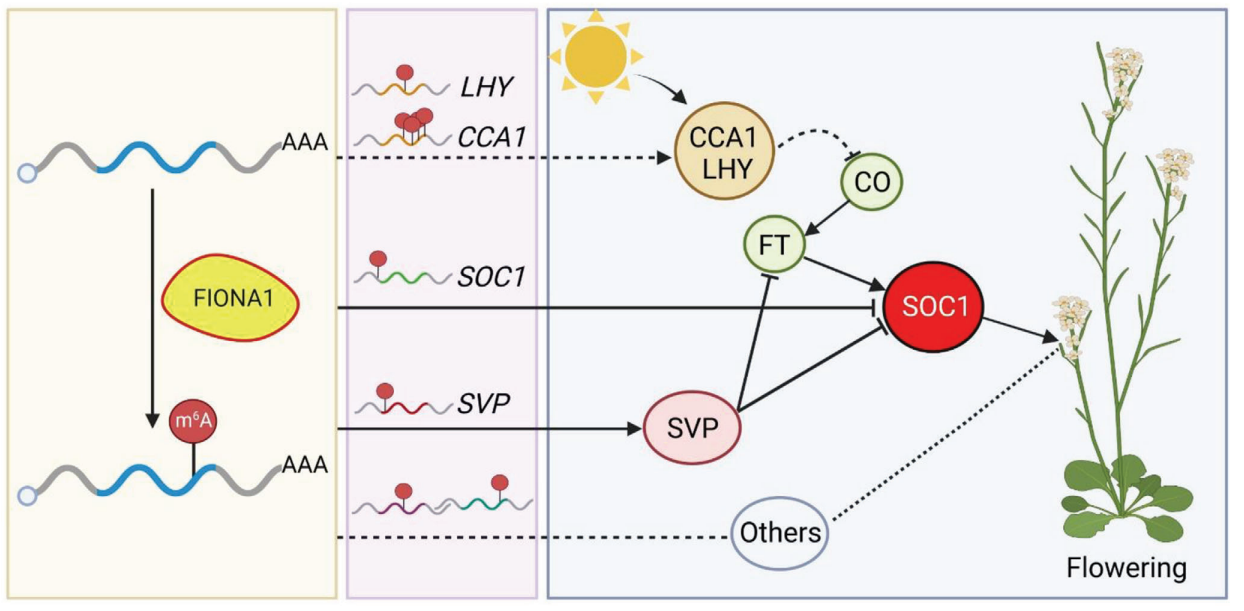FIONA1-Mediated m6A Modification Regulates the Floral Transition in Arabidopsis
Release time:2022-04-28 15:19 Author:Benagen
Abstract
N6-methyladenosine (m6A) mRNA modification represents the most widespread form of internal modifications in eukaryotic mRNAs. In the model plant Arabidopsis thaliana, those known methyltransferases mainly deposit m6A at their target transcripts near the stop codon or in the 3′ untranslated region. Here, it is reported that FIONA1 (FIO1), a human METTL16 ortholog, acts as a hitherto unknown m6A methyltransferase that determines m6A modifications at over 2000 Arabidopsis transcripts predominantly in the coding region. Mutants of FIO1 show a decrease in global m6A mRNA methylation levels and an early-flowering phenotype. Nanopore direct RNA sequencing reveals that FIO1 is required for establishing appropriate levels of m6A preferentially in the coding sequences of a subset of protein-coding transcripts, which is associated with changes in transcript abundance and alternative polyadenylation. It is further demonstrated that FIO1-mediated m6A methylation determines the mRNA abundance of a central flowering integrator SUPPRESSOR OF OVEREXPRESSION OF CONSTANS 1 (SOC1) and its upstream regulators, thus preventing premature flowering. The findings reveal that FIO1 acts as a unique m6A methyltransferase that mainly modifies the coding regions of transcripts, which underlies the key developmental transition from vegetative to reproductive growth in plants.
 Fig1 FIO1 affects flowering and mRNA m6A levels in Arabidopsis
Fig1 FIO1 affects flowering and mRNA m6A levels in Arabidopsis
 Fig 2 A proposed model depicting the function of FIO1 in m6A modifification and flflowering time control in Arabidopsis
Fig 2 A proposed model depicting the function of FIO1 in m6A modifification and flflowering time control in Arabidopsis
References
Xu T, et al. FIONA1-Mediated m6A Modification Regulates the Floral Transition in Arabidopsis. Advanced Science, 2022
N6-methyladenosine (m6A) mRNA modification represents the most widespread form of internal modifications in eukaryotic mRNAs. In the model plant Arabidopsis thaliana, those known methyltransferases mainly deposit m6A at their target transcripts near the stop codon or in the 3′ untranslated region. Here, it is reported that FIONA1 (FIO1), a human METTL16 ortholog, acts as a hitherto unknown m6A methyltransferase that determines m6A modifications at over 2000 Arabidopsis transcripts predominantly in the coding region. Mutants of FIO1 show a decrease in global m6A mRNA methylation levels and an early-flowering phenotype. Nanopore direct RNA sequencing reveals that FIO1 is required for establishing appropriate levels of m6A preferentially in the coding sequences of a subset of protein-coding transcripts, which is associated with changes in transcript abundance and alternative polyadenylation. It is further demonstrated that FIO1-mediated m6A methylation determines the mRNA abundance of a central flowering integrator SUPPRESSOR OF OVEREXPRESSION OF CONSTANS 1 (SOC1) and its upstream regulators, thus preventing premature flowering. The findings reveal that FIO1 acts as a unique m6A methyltransferase that mainly modifies the coding regions of transcripts, which underlies the key developmental transition from vegetative to reproductive growth in plants.


References
Xu T, et al. FIONA1-Mediated m6A Modification Regulates the Floral Transition in Arabidopsis. Advanced Science, 2022
 027-62435310 |
027-62435310 |
 service@benagen.com |
service@benagen.com |



